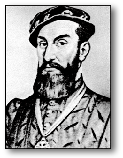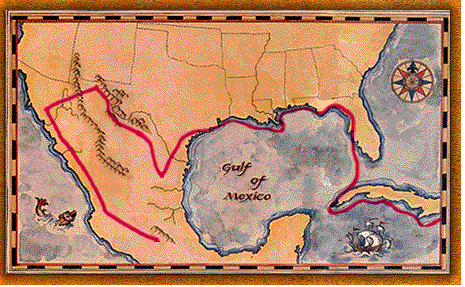|
|
||||
 |
||||
Alvar Nuñez Cabeza de Vaca

(c.1490-c.1557)
The journey of Alvar Nuñez Cabeza de Vaca remains one of the most amazing feats of exploration in the Americas.
Cabeza de Vaca was born into the Spanish nobility in 1490. Little of his early life is known, except that he made his career in the military. In early 1527 he left Spain as a part of a royal expedition intended to occupy the mainland of North America.
 After
their fleet was battered by a hurricane off the shore of Cuba, the expedition
secured a new boat and departed for Florida. They landed in March 1528 near what
is now Tampa Bay, which the expedition leader, Pánfilo de Narváez, claimed as
the lawful possession of the Spanish empire.
After
their fleet was battered by a hurricane off the shore of Cuba, the expedition
secured a new boat and departed for Florida. They landed in March 1528 near what
is now Tampa Bay, which the expedition leader, Pánfilo de Narváez, claimed as
the lawful possession of the Spanish empire.
Despite this confident declaration, the expedition was on the verge of disaster. Narváez's decision to split his land and sea forces proved a grievous error, as the ships were never able to rendezvous with the land expedition. The party soon overstayed its welcome with the Apalachee Indians of northern Florida by taking their leader hostage. Expelled and pursued by the Indians, suffering from numerous diseases, the surviving members of the expedition were reduced to huddling in a coastal swamp and living off the flesh of their horses. In late 1528, they built several crude rafts from trees and horse hides and set sail, hoping to return to Cuba.
Storms, thirst and starvation had reduced the expedition to about eighty survivors when a hurricane dumped Cabeza de Vaca and his companions on the Gulf Coast near what is now Galveston, Texas. They were initially welcomed, but, as Cabeza de Vaca was to remember, "half the natives died from a disease of the bowels and blamed us." For the next four years he and a steadily dwindling number of his comrades lived in the complex native world of what is now East Texas, a world in which Cabeza transformed himself from a conquistador into a trader and healer.
By 1532, only three other members of the original expedition were still alive -- Alonso del Castillo Maldonando, Andrés Dorantes de Carranca, and Estevan, an African slave. Together with Cabeza de Vaca, they now headed west and south in hopes of reaching the Spanish Empire's outpost in Mexico, becoming the first men of the Old World to enter the American West. Their precise route is not clear, but they apparently traveled across present-day Texas, perhaps into New Mexico and Arizona and through Mexico's northern provinces. In July 1536, near Culiacán in present-day Sinaloa, they finally encountered a group of fellow Spaniards who were on a slave-taking expedition. As Cabeza de Vaca remembered, his countrymen were "dumbfounded at the sight of me, strangely dressed and in company with Indians. They just stood staring for a long time."
Appalled by the Spanish treatment of Indians, in 1537 Cabeza de Vaca returned to Spain to publish an account of his experiences and to urge a more generous policy upon the crown. He served as a Mexican territorial governor, but was soon accused of corruption, perhaps for his enlightened conduct toward Indians. He returned to Spain and was convicted; a 1552 pardon allowed him to become a judge in Seville, Spain, a position which he occupied until his death in 1556 or 1557.